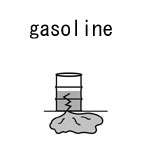| Case Name |
Overflow of gasoline from a plain gasoline tank of a factory |
| Pictograph |

|
| Date |
September 6, 1995 |
| Place |
Kawasaki, Kanagawa, Japan |
| Location |
Chemical factory |
| Overview |
Gasoline overflowed from a plain tank for supplying gasoline to automobiles of the factory. Improper tank level control of the plain tank with a meter was a cause. |
| Incident |
Gasoline overflowed from a bleeder when a private, simple gasoline tank (with a meter) was supplied with gasoline from drum cans. |
| Processing |
Consumption and usage |
| Substance |
Gasoline |
| Type of Accident |
Leakage |
| Sequence |
On September 5th, 1995, an employee of a subcontractor which controlled the level of a plain gasoline tank got a notice that two of three plain tanks were empty. He followed a procedure to supply gasoline to the tanks on the next day.
In the morning on September 6th, the employee of a different subcontractor received instructions of the supply work, and he followed the prescribed procedure. Four drum cans with 800 L gasoline were prepared, and supplying to two tanks started. One tank was supplied with two drum cans of 400 L. Then, he started to supply the other tank. Gasoline overflowed from a bleeder of the tank when he had supplied the tank with almost 400 L. |
| Cause |
The supply volume was ordered without confirming the tank volume. In addition, the supplying worker did not confirm the tank level. As a result, the gasoline overflowed. Refer to Fig2. |
| Response |
The supply pump was stopped, and leaked oil was treated with adsorption sheets. |
| Countermeasures |
1. It is confirmed that supply is requested when the liquid level is in the EMPTY zone of the level gauge.
2. The quantity supplied at one time is set at 300 L.
3. The liquid level gauge has to be watched during supply work, and when it reaches 400 L, supply work is stopped.
4. Education on duties and obligations in work execution, etc. are carried out for workers and protection supervisors. |
| Knowledge Comment |
1. Controlling within the band (zone) needs attention. There is a case in which the meaning differs among the upper end, the lower end, and the middle part, even inside the band. The lower end of FULL seems to be the limit of a safe capacity, and the upper end seems to be the mechanical limit of the tank.
2. Compared with the main facilities of the factory, satisfactory attention might not be paid to plain facilities of peripheral parts. The possibility of an accident is the same even if the facilities treat only a small amount of materials. Small facilities often have insufficient safety equipment, etc. Caution is required. |
| Background |
1. There were improper instructions. It is not appropriate that the quantity supplied is always to be 400 L. As shown in Fig. 2, the indication of the level gauge has some width at EMPTY and FULL, and judging from the upper end of EMPTY and lower end of FULL, only 300 L or a little more gasoline could be supplied. Although the meaning of the lower end of FULL was not clear, a worker should not supply above this level, regarding it as the safety limit.
2. The facilities had no instruments to prevent a hazardous situation and depended on only human attention.
3. From the human point of view, there might be defects in education or a manual. The supplying manner, which means when the supply should be done and how much quantity should be supplied, might not be clearly regulated. |
| Incidental Discussion |
At a large plant, management and operation of peripheral plain facilities are often entrusted to subcontractors. Generally, the level of technology of such subcontractors and their employees are often lower than that of consignors. Work is carried out by the entrusted subcontractor according to the indications of the consignor. Sufficient information about meaning, capacity, safety equipment, work methods of facilities should be given by the consignor. Moreover, it will be a duty of the consignor to provide training and education for the subcontractor's manager. |
| Reason for Adding to DB |
Example of overflow from inadequate management of a plain tank, which is also hazardous equipment. |
| Scenario |
| Primary Scenario
|
Poor Value Perception, Poor Safety Awareness, Inadequate Risk Recognition, Ignorance, Insufficient Knowledge, Insufficient Study, Organizational Problems, Inflexible Management Structure, Insufficient Education/Training, Planning and Design, Poor Planning, Poor Design, Bad Event, Mechanical Event, Tank Overflow
|
|
| Sources |
Kawasaki City, Fire fighting station, Prevention division, Peace section. T Chemcal Co., Ltd. K factory. Outline of gasoline overflow accident at gasoline plain tank. Material of the Kawasaki City Complex safety countermeasure committee(1995)
|
| Physical Damage |
An overflow of gasoline from a plain gasoline tank of a factory. |
| Multimedia Files |
Fig2.Tank construction plan
|
| Field |
Chemicals and Plants
|
| Author |
KOBAYASHI, Mitsuo (Office K)
TAMURA, Masamitsu (Center for Risk Management and Safety Sciences, Yokohama National University)
|
|